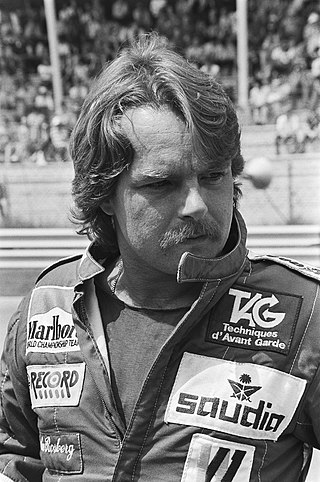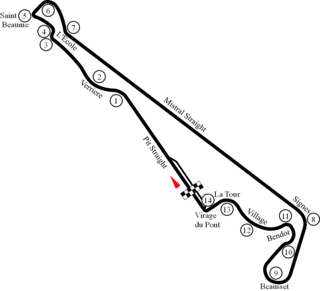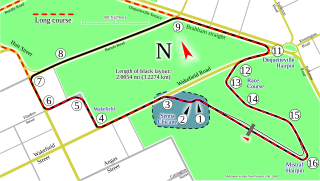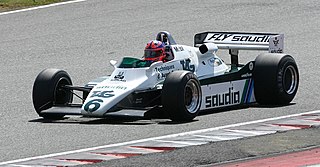
Keijo Erik Rosberg, known as "Keke", is a Finnish former racing driver and winner of the 1982 Formula One World Championship. He was the first Finnish driver to compete regularly in the series, as well as the first Finnish champion. He is the father of 2016 Formula One World Champion Nico Rosberg.

The 1983 European Grand Prix was a Formula One motor race held at Brands Hatch on 25 September 1983. It was the fourteenth race of the 1983 Formula One World Championship.

The 1985 French Grand Prix was a Formula One motor race held at Paul Ricard on 7 July 1985. It was the seventh race of the 1985 Formula One World Championship. It was the 63rd French Grand Prix and the ninth to be held at Paul Ricard. The race was held over 53 laps of the 5.81-kilometre (3.61 mi) circuit for a total race distance of 307.93 kilometres (191.34 mi).

The 1985 European Grand Prix was a Formula One motor race held at Brands Hatch on 6 October 1985. It was the fourteenth race of the 1985 Formula One World Championship.

The 1985 Australian Grand Prix was a Formula One motor race held on the Adelaide Street Circuit in Adelaide on 3 November 1985. The sixteenth and final race of the 1985 Formula One World Championship, it was the 50th running of the Australian Grand Prix and the first to be held on the streets of Adelaide on a layout specifically designed for the debut of the World Championship in Australia. The race was held over 82 laps of the 3.780 km (2.362 mi) circuit for a total race distance of 310 kilometres. The race was won by Keke Rosberg driving a Williams-Honda; this was the final win for Rosberg and the last by a Finnish driver until Mika Häkkinen won the 1997 European Grand Prix.

The 1986 Italian Grand Prix was a Formula One motor race held at Monza on 7 September 1986. It was the thirteenth race of the 1986 Formula One World Championship.

The 1986 Australian Grand Prix was a Formula One motor race held on 26 October 1986 at the Adelaide Street Circuit, Adelaide, Australia. It was the sixteenth and final race of the 1986 Formula One World Championship. The race decided a three-way battle for the Drivers' Championship between Brit Nigel Mansell, driving a Williams-Honda; his Brazilian teammate Nelson Piquet; and Frenchman Alain Prost, driving a McLaren-TAG.

The 1987 French Grand Prix was a Formula One motor race held on 5 July 1987 at the Circuit Paul Ricard, Le Castellet. It was the sixth race of the 1987 Formula One World Championship. It was the 65th French Grand Prix and the eleventh to be held at Paul Ricard, and the second to be held on the shortened version of the circuit. The race was held over 80 laps of the 3.813-kilometre (2.369 mi) circuit for a race distance of 305.040 kilometres (189.543 mi).

The 1989 Italian Grand Prix was a Formula One motor race held at Monza on 10 September 1989. It was the twelfth race of the 1989 Formula One season.

The 1988 FIA Formula One World Championship was the 42nd season of FIA Formula One motor racing. It featured the 1988 Formula One World Championship for Drivers and the 1988 Formula One World Championship for Constructors, which were contested concurrently over a sixteen-race series that commenced on 3 April and ended on 13 November. The World Championship for Drivers was won by Ayrton Senna, and the World Championship for Constructors by McLaren-Honda. Senna and McLaren teammate Alain Prost won fifteen of the sixteen races between them; the only race neither driver won was the Italian Grand Prix, where Ferrari's Gerhard Berger took an emotional victory four weeks after the death of team founder Enzo Ferrari. McLaren's win tally has only been bettered or equalled in seasons with more than sixteen races; their Constructors' Championship tally of 199 points, more than three times that of any other constructor, was also a record until 2002.

The 1986 FIA Formula One World Championship was the 40th season of FIA Formula One motor racing. It featured the 1986 Formula One World Championship for Drivers and the 1986 Formula One World Championship for Manufacturers, both of which commenced on 23 March and ended on 26 October after sixteen races. The Drivers' Championship was won by Alain Prost, and the Manufacturers' Championship was won by Williams-Honda, thus Honda became the first Japanese engine supplier World Champions of Formula One, and adding a constructors' title to Frank Williams' trophy collection. Prost was the first driver to win back-to-back Drivers' Championships since Jack Brabham in 1959 and 1960.

The 1985 FIA Formula One World Championship was the 39th season of FIA Formula One motor racing. It began on 7 April and ended on 3 November after sixteen races. The World Championship for Drivers was won by Alain Prost, and the World Championship for Manufacturers was won by McLaren for the second consecutive year.

The Adelaide Street Circuit is a temporary street circuit in the East Parklands adjacent to the Adelaide central business district in South Australia, Australia.

The McLaren MP4/2 was a Formula One car produced by McLaren for the 1984 season. An iteration of it, the MP4/2B, was used in the 1985 season, and a slightly updated version, the MP4/2C, raced in the 1986 season for McLaren. It was closely based on the MP4/1E model that was used as a test car, used in the final races of 1983.

The Williams FW11 was a Formula One car designed by Frank Dernie as a serious challenger to McLaren and their MP4/2C car. The car took over from where the FW10 left off at the end of 1985, when that car won the last three races of the season.

The 1983 Race of Champions was a non-championship Formula One race held at Brands Hatch on 10 April 1983. Contested over 40 laps, it was the final non-championship F1 race to be held in the sport's history. Reigning World Champion Keke Rosberg won in a Williams-Ford, narrowly beating the Tyrrell-Ford of F1 rookie Danny Sullivan, while 1980 World Champion Alan Jones was third in an Arrows-Ford.

The Ferrari F1/86 was the car with which Scuderia Ferrari competed in the 1986 Formula One World Championship. The car was designed by Harvey Postlethwaite, who had also designed its predecessor, the 156/85. It was driven by Italian Michele Alboreto and Swede Stefan Johansson. The car was very uncompetitive, despite the engine being regarded as one of the strongest on the grid. It was replaced by the Ferrari F1/87 for 1987.

The Williams FW09 was a Formula One car designed by Frank Dernie and Neil Oatley. It was the first Williams chassis to be powered by a turbocharged Honda V6 engine, for which Frank Williams negotiated a deal towards the end of 1982 and the beginning of 1983.

The Williams FW08 was a Formula One car designed by Frank Dernie, which debuted at the 1982 Belgian Grand Prix held at the Zolder circuit. An evolution of the FW07 that it replaced, the car was used by Finnish driver Keke Rosberg to win the 1982 World Drivers' Championship.

The Honda RA16 engine is a highly-successful and extremely powerful, turbocharged, 1.5-litre, 80-degree, V-6 racing engine, designed for use in Formula One; between 1983 and 1988. The customer engines were used by Spirit, Williams, Lotus, and McLaren.




















